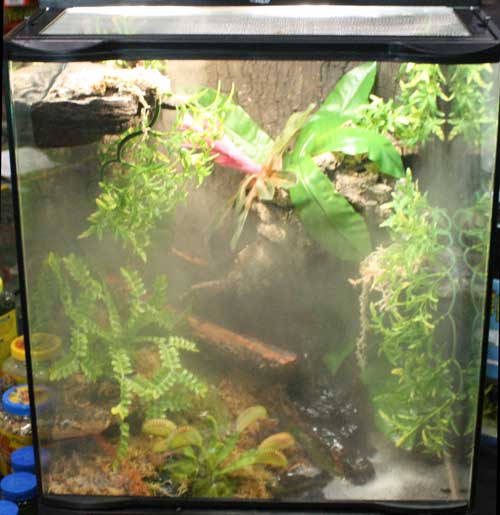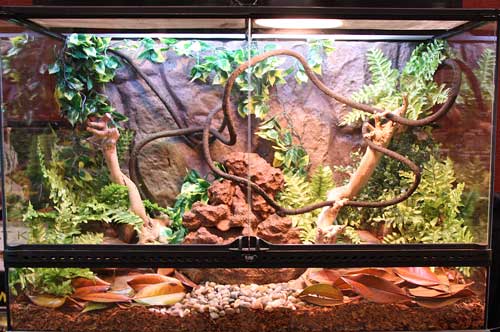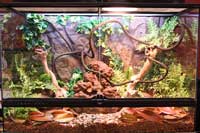Using live plants in vivaria for reptiles and amphibians.
 |
Living plants are a valuable addition to vivaria for many reasons. In fact, they are so beneficial that they really should be considered a standard component of most vivaria for most kinds of herps. There are reasons why really serious keepers of many of the more rare, pricey and difficult herps tend to know about, and use, a lot of living plants, and why you can frequently meet the same people at both herp shows and plant shows. The beauty and naturalistic look plants bring to a vivarium are important considerations but by no means the only ones.

Plants for reptile and amphibians vivariums.
Waste Management Specialists
In some vivaria, especially tropical rain forest, temperate forest, bog and aquatic setups containing small animals whose wastes are not easy to locate or remove, plants can play a crucial role in maintaining a healthy environment. In some cases, where animal and plant populations are properly balanced, the plants may be able to maintain a healthy environment for long periods of time, even years, without the need to break down the vivarium for a substrate change or complete water change.

Planting a reptile vivarium for reptiles and amphibians.
The primary cause of vivarium pollution is the buildup of nitrogen compounds due to animal waste. When animals deposit waste, it is broken down by bacteria into ammonia, then to nitrite and finally to nitrate. Ammonia and nitrite are both toxic in excess, but it is primarily the nitrate that builds up in the vivarium substrate and water, causing pollution. This toxic environment will sicken and kill animals unless the substrate or water is cleaned out and replaced with fresh. The total vivarium breakdown that will be necessary will disturb the animals and ruin a beautiful, established landscape, as well as require money for new materials. A properly planted vivarium, however, can spare you this hassle.
Plants are the “end users” of nitrogen compounds in the nitrogen cycle. They need nitrogen compounds in relatively large amounts to live and grow. Various kinds of plants can use all forms of nitrogen, including urea, ammonia, nitrite and nitrate, but it is the plants’ ability to use up the nitrate that keeps the substrates and water in planted vivariums clean and healthy. Then you simply need to occasionally prune your healthy, vigorously growing plants.
A Breath of Fresh Air
As part of their natural respiratory process, plants remove carbon dioxide from the air and add oxygen and humidity. Therefore, they help maintain air quality in an enclosed environment, whether it is a mall, a room or a vivarium. This is especially useful if you need an enclosed vivarium with minimum fresh air circulation from the outside in order to maintain high humidity for certain animals. The plants will not only help increase humidity, they will help keep the air composition balanced and healthy by using the carbon dioxide produced by the animals and replacing it with oxygen. They can also remove other toxic gasses.
Ever walk into a greenhouse and smell the freshness and feel the humidity? This is what a tropical vivarium should smell and feel like if it is properly landscaped with plants.
Environmental Protection Agents
In general, herps and plants from the same kind of habitat need the same environmental characteristics to be healthy. They need the same temperature, humidity, light, air quality, substrate composition and moisture. The condition of your plants can then give you a good idea about the overall health of your vivarium, including how it may be affecting your animals.
You will often see signs of environmental problems in plants before you see them in the animals. Because signs of illness or stress in animals can attract the unwanted attention of predators or rivals, they tend to try to hide any such signs. You might not know anything is really wrong until the animal is extremely ill or dies. But plants are right there, out in full view, showing the effects of the environment. Stunted, unhealthy looking plants indicate an environment with serious problems, which probably means your animals are under significant stress as well.
Healthy plants should look vigorous and robust. They should be firm and upright, or whatever position is normal for the species, with healthy leaves of good color. New leaf growth and overall steady growth are other signs of healthy plants.
The Structures of Life
In nature, plants are important environmental structures that provide living space and shelter for the majority of animals, whether arboreal (tree-living), terrestrial (ground-living), fossorial (underground-living) or aquatic (water-living). They are important structural elements in vivaria as well.
There are many kinds of popular herps that live in, on, under or among plants in their natural habitats. They use trees, shrubs, vines, grasses, trunks, branches, leaves, flowers and roots. They use both living plants and the dead remnants of plants, such as hollow trunks, fallen branches and duff, the layers of decaying leaves and other matter covering a forest floor. While it is possible to provide similar artificial structures in vivaria, there are many attributes of real plants that contribute to the physical and mental health of herps. It may have to do with physical characteristics, chemical signatures, smells, tastes, textures, colors, etc. There are nuances about real plant materials that make them just seem “right” to animals, and that make them feel comfortable and secure. Using real plants can make a difference, whether significant or slight, in how well an animal feels, how naturally it behaves, whether or not it eats and/or reproduces, how healthy it is and how long it lives.
Find out how your herp lives in its natural habitat and how it utilizes the plants. A red-eyed treefrog (Agalychnis callidryas) will always do better if it has nice, big, smooth green leaves, such as those of split-leaf philodendron (Monstera deliciosa) or peace lily (Spathiphyllum spp.) to hunker down on during the day. A serrated-tailed or neon blue-tailed tree lizard (Holaspis guentheri) can only be truly at ease when it has an upright trunk or large branch with deep bark furrows and/or cracks into which it can slip when it feels threatened. A painted reed frog (Hyperolius viridiflavus taeniatus) needs stiff, generally vertical, grass- or reed-like plant leaves, like those of such plants as lily turf (Liriope spp.) or zebra rush (Scirpus ‘Zebrinus’) to sit among during the day. Without them the frog will cower miserably in a corner of the enclosure until it dies from stress. Without a nice, thick layer of dead leaves punctuated with small, low-hanging shrubs, a Tanzanian leaf chameleon (Rieppeleon brevicaudata) is the very picture of vulnerability and distress. You get the point.
See the “Plants for Vivaria” section for a listing of some of the more common plants you can use for various types of vivaria and herps.
|
Plants for Vivaria |
|||
| These are just a few of the most common plants found in plant shops, nurseries and home-improvement stores. Many other desirable and useful species can be found at specialty plant growers or nurseries, plant society shows and sales, reptile shows and through advertisements in magazines. The Internet is an excellent place to look, too. Not all of these plants are appropriate for all of these species. Research the needs of the herps you keep. | |||
|
Category of Plants, Vivaria & Herps |
Plants to Consider |
||
| Trees and woody shrubs for arboreal herps such as some chameleons, boas, pythons, some tree frogs, etc., in tropical vivaria | Tropical fig trees, such as weeping fig (Ficus benjamina) and other Ficus spp.; Hibiscus spp; and umbrella plant (Schefflera arboricola) | ||
| Leafy shrubs and low-cover plants for some arboreal species, such as day geckos and some tree frogs, etc. Also for terrestrial species, such as some dart frogs, other frogs and toads, some lizards and some snakes in tropical vivaria | Chinese evergreen (Aglaonema spp.); dumbcane (Dieffenbachia spp.); peace lily (Spathiphyllum spp.); Begonia spp.; ferns (many spp.); small palms (many spp.); dracaenas (Dracaena spp.); ti plants (Cordyline spp.) | ||
| Vine-like plants for some of the same arboreal species and terrestrial species listed above in tropical vivaria | Split-leaf philodendron (Monstera deliciosa); pothos (Epipremnum pinnatum); ivy (Hedera spp.) | ||
| Epiphytic plants for many dart frogs, other tree frogs, some salamanders, certain lizards and certain snakes in tropical vivaria — many can also be used ornamentally | Bromeliads (Neoregelia spp., Guzmania spp., Aechmea spp., etc.); tillandsias (Tillandsia spp.); many orchids (Orchidaceae spp.); some ferns (Pteridophyta spp.); some Lycopodium spp. | ||
| Trees and woody shrubs for arboreal herps such as some tree frogs, some tree lizards and some snakes in temperate vivaria | Azaleas (Rhododendron spp.); camellias (Camellia spp.); boxwoods (Buxus spp.); gardenias (Gardenia spp.); pineapple guava (Feijoa sellowiana) | ||
| Leafy shrubs and low-cover plants for temperate vivaria | Begonias (many species); ferns (many species); Cyclamen spp.; turf lilies (Liriope spp.); mondo grass (Ophiopogon japonicus); African violets (Saintpaulia spp.); primroses (Primula spp.); violets (Viola spp.) | ||
| Trees and woody shrubs for arboreal species such as some chameleons, some tree lizards and some snakes in dry and desert vivaria | Bougainvillea spp., shrub types; sages (Salvia spp.); manzanita (Arctostaphylos spp.); junipers, upright (Juniperus spp.); wormwoods (Artemisia spp.). | ||
| Low-cover shrubs for terrestrial species, such as many lizards and snakes in dry and desert vivaria; ornamental and structural plants | Junipers, prostrate (Juniperus spp.); wormwoods, low (Artemesia spp.); Lantana spp.; lavender cotton (Santolina chamaecyparissus); many succulents and cacti | ||
| Trees and woody shrubs for bog vivaria | Bald, pond and Montezuma cypresses (Taxodium distichum , T. ascendens and T. mucronatum); mangroves (Rhizophora spp., Avicennia spp., Laguncularia spp.); water tupelo (Nyssa aquatica) | ||
| Leafy shrubs and cover plants for bog vivaria | Anubias spp.; Cryptocoryne spp.; peace lily (Spathiphyllum spp.); Japanese sweet flag (Acorus gramineus); taros (Colocasia spp., Xanthosoma spp.); Canna spp.; arrowheads (Sagittaria spp.); sword plants (Echinodorus spp.) | ||
| Non-living plant materials for certain arboreal chameleons, geckos and other tree lizards, some snakes, some frogs, etc. | Standing logs, branches or bark; some smooth and some with splits or rough or crevassed bark; some with holes and interior cavities | ||
| Non-living plant materials for certain terrestrial and fossorial species of frogs and toads, salamanders, leaf chameleons, some geckos, other lizards and snakes | Fallen logs or branches, with various cavities, etc.; leaf litter of various leaf sizes, decomposition states and depth | ||
Preparing Plants for Vivaria
Plants sometimes come from your supplier with certain conditions that can be bad for your vivarium and animals. They may have pesticides or synthetic fertilizer residues on their leaves, which can harm herps, or they may carry various pests. They are probably growing in a potting mix containing materials that could create problems in a vivarium.
Before Buying
Check plants for pests, such as aphids, spider mites, other mites, scale, mealy bugs, leaf miners, snails, slugs, centipedes, sow bugs and earwigs. Check both sides of leaves, stems, base and roots in the top layer of potting mix. If you’re unfamiliar with any of these pests, check the Internet for photos and descriptions.
Some pests are easily removed; others are more difficult. If you see any, your best course of action is to not buy the plant. If it’s a really nice or rare plant that you have to have and you think you can get rid of the pests, you can try it, but be careful. Once established in a vivarium, some pests can be hard to eliminate.
Evaluate the plant’s overall health. Avoid plants with dropping or discolored leaves, wilting, soft or mushy stems, crisp leaves, etc.
Vivarium Prep
- Prune and shape the plant while it is still in its pot. For trees or large, woody shrubs, this is the time to do initial bonsai-style training.
- Gently wipe the leaves with a small sponge soaked in lukewarm water and containing a mild dish soap. Rinse them with clean, lukewarm water.
- Tap the plant out of its pot, and gently remove as much of the potting mix from the roots as you can without harming them. Remove any white or silvery components in the mix. It’s okay if some potting mix is left within the root ball, as long as it is completely surrounded by the vivarium substrate mix once it’s planted. The root balls of most plants can be gently spread apart to flatten or shape them to fit the depth of your vivarium substrate.
Using Plants with Herbivorous Herps
Obviously, using living plants in a vivarium inhabited by herbivorous herps is problematic. Some of the most commonly kept herbivorous reptiles are bearded dragons, iguanas, Solomon Island (prehensile-tailed) skinks and various tortoises. All are likely to destroy your nice landscape, not only because they are herbivorous, but because they are also large. With knowledge and experience, however, you can create a planted vivarium for most herbivorous herps, using plants that are large and/or tough, or plants that have a noxious taste.
Some large bromeliads are extremely tough, with fibrous leaves that are extremely difficult to tear. They also contain few fleshy components that could be a food source and many appear to be distasteful. Such bromeliads can be used in iguana enclosures with little likelihood that the lizards will bother them, especially if proper food is provided. They can be securely attached to large branches using an organic twine, in areas that the iguanas do not use for traveling or basking. With proper care, the bromeliads will grow roots and attach themselves to the branch. They will then develop offshoots, eventually forming attractive clumps. The twine gradually decomposes, and a beautiful, tropical-looking enclosure will result.
For a bearded dragon vivarium, a savin juniper (Juniperus sabina), elephant tree (Bursera microphylla) or manzanita (Arctostaphylos sp.) makes a nice desert-tree centerpiece. Each is tough and contains resins, turpenes and other chemicals that make them taste foul, so the dragon will leave them alone.
Plants can also be placed out of reach, such as a fern growing from a pocket in a tree stump, where a tortoise could not reach it.
Find plants that will work in your situation. When selecting plants for use in herbivorous herp vivaria, however, be sure they are not toxic. It is relatively easy to find this out via the Internet.
Vivarium Plant Care
Caring for vivarium plants is easy. If you have properly set up your vivarium with everything your herps need, then the plants’ needs will be met as well.
Always use a good vivarium substrate mix. Recipes for different mixes can be found at reptilechannel.com/kid-corner/ beginner-herps/reptile-vivarium-planting-mixes.aspx. Use lights that simulate natural sunlight in both spectrum and intensity, such as high-power compact fluorescents. Keep your vivarium at the appropriate temperature and humidity levels that your herps require, and maintain the correct degree of moisture in the substrate.
You can occasionally use a quality, all-purpose, organic foliar fertilizer, such as Dyna-Gro, at about half the strength indicated on the label directions. This won’t be necessary, however, if your vivarium contains lots of little animals, such as dart frogs and geckos, that are already providing the most natural of fertilizers. Desert vivarium plants need little or no fertilizer other than what was originally included in the vivarium substrate mix.
Vivarium plants must also be occasionally pruned to keep them looking good and in scale with the vivarium. After some practice, you will find you can become quite good at this. I always recommend taking a class on bonsai techniques, or getting a good bonsai book. These techniques are very helpful when working on vivarium trees and large, woody shrubs.
Plant ‘Em!
Nothing else can give a vivarium a beautiful, naturalistic look like living plants. Anyone who has seen a beautifully landscaped vivarium knows what a fantastic showcase it is in which to display reptiles and amphibians. Unless you’re a laboratory researcher or a large-scale breeder, your herps are probably either pets or prized collector specimens. You keep them because you appreciate and admire them, and you want to display them in a way that will make them look their best for you, your family and friends, and your fellow herp enthusiasts. Use live plants to do exactly that!


